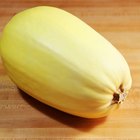
Deep frying requires oil to be heated to high temperatures in excess of 300 degrees Fahrenheit. To choose an oil for frying, you must know its smoke point. The smoke point is the temperature the oil begins smoking. Heating the oil beyond the smoke point to the flash point results in ignition of the oil. Each time you reuse oil, the smoke and flash points decrease by up to 100 degrees Fahrenheit. Choosing vegetable oils with the highest initial smoke points will prevent the oil from smoking with subsequent uses.
Peanut Oil
Peanuts grow in the ground and are botanically considered legumes. Peanut oil could therefore be considered a vegetable oil instead of a nut oil as it does not come from a tree nut. Peanut oil is readily available in gallon-sized and larger containers at supermarkets and camping stores. This is the oil of choice for deep frying turkeys. It has a mild taste and a high smoke point of 450 degrees Fahrenheit. This oil can be used with all deep frying applications. The oil itself, though consists of 17 percent saturated fat.
Safflower Oil
Like peanut oil, safflower oil has a high smoke point of 450 degrees Fahrenheit. This oil does not impart any flavor on the food, and it contains less saturated fat than other vegetable oils. Safflower oil contains 9 percent saturated fat. Do not confuse safflower oil with sunflower oil. Sunflower oil has a much lower smoke point of 390 degrees Fahrenheit. Keep safflower oil in the refrigerator and eat products fried in it immediately to avoid the rapid rate this oil breaks down to create rancid flavors and odors, warns Shirley O'Corriher in "Cookwise."
Soybean Oil
Soybean oil might be difficult to find, but if you do locate it with the other oils in gourmet grocery stores, health food stores or on the Internet, get it for deep frying. This oil contains 14 percent saturated fat, and it has a smoke point of 450 degrees Fahrenheit. It's light color and flavor do not significantly alter the flavor of foods cooked in it.
Canola Oil
Canola oil is the name given to a strain of low erucic acid rapeseed oil. This vegetable oil is easily found in supermarkets. It has a high smoke point of 437 degrees Fahrenheit. Though canola oil has a slightly lower smoke point than other oils, its availability makes it one of the best deep frying oil options. "The Food Substitutions Bible" notes that canola oil has no flavor and a low 6 percent saturated fat content. Shriley O'Corriher notes that though canola oil has no natural flavor, deep frying lightly flavored foods might result in the diner detecting slight bean-like overtone from the canola oil. This taste will be undetectable in most seasoned fried foods.
Related Articles

What is Rapeseed Oil?

Can Doughnuts Be Deep Fried in Olive ...

Substitutes for Groundnut Oil in Cooking

The Shelf Life of Pumpkin Seed Oil

Cold Pressed vs. Expeller Pressed
Cooking With Camellia Oil
How Long Can You Keep and Reuse Peanut ...

Sesame & Peanut Oil for Cooking

Do You Need to Refrigerate Infused ...

What Kind of Oil Should I Use to ...

How to Deep-Fry Frozen Potstickers

What Is Expeller Pressed Canola Oil?

Can Borage Oil Help Acne?

Can You Use Olive Oil in a Bread Mix?

Calories in Spaghetti Squash Seeds

How to Dilute Patchouli Oil

Homemade Conditioner With Jojoba Oil

Cooking Oils With Low Smell

Eucalyptus Oil & Acne

Can I Make Fried Chicken With Butter ...
References
- "Cookwise"; Shirley O'Corriher; 1998
- "I'm Just Here For the Food"; Alton Brown; 2002
- "The Food Substitutions Bible"; David Joachim; 2005
Photo Credits
Jupiterimages/Photos.com/Getty Images